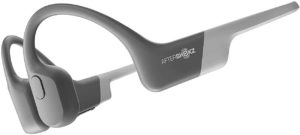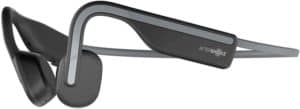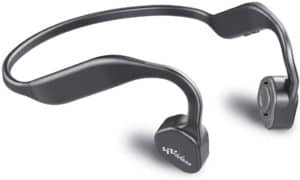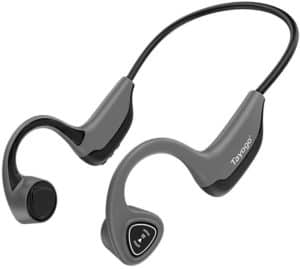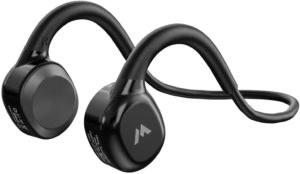Best Bone Conduction Headphones in 2023
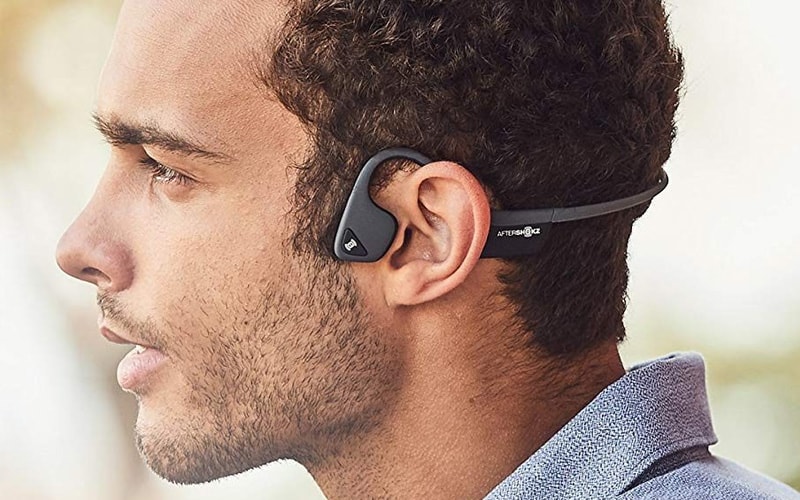
If you’re looking for the best bone-conduction headphones, we’ve got you covered right here.
Whether you need some motivational tunes while exercising or want to enjoy the pleasure of music as a hard-of-hearing person, bone conduction earphones exist as a great alternative to traditional headphones.
Although the technology’s origins trace back to hearing aids, it’s found a niche in the headphone market chiefly for the safety benefits it provides athletes. By channeling vibrations through facial bones to the inner ear rather than pushing sound waves through the ear canal, they allow users to remain aware of their surroundings while enjoying music. Unlike regular headphones, they don’t seal in the eardrum and block out ambient sounds.
As with all consumer products, the challenge is wading through the PR blather to find the very best devices in a sea of duds. To that end, we’ve set our sights on the best bone conduction headphones out there.
Products at a Glance
How we picked the best bone conduction headphones
There’s no doubt that there are far fewer bone conduction headphone options out there than traditional headphones, which somewhat narrows down the choice. Nevertheless, the market is awash with terrible options that will have you regretting your purchase before you’ve even returned home from your first run.
While on the hunt for the best bone conduction headphones, we paid close attention to a few core features. In no particular order: design, comfort, sound quality, battery life, connectivity, sweat/waterproofing, and of course, price.
Five bone conduction headphones piqued our interest by amalgamating all the above features together in a well-rounded pair of headphones. We’ve covered different price points to reach as many budgets as possible. Read on for our reviews of the best bone conduction headphones on the market today.
Product Reviews
- Superb battery life
- Lightweight
- Snug, comfortable fit
- Audio quality
- Price
AfterShokz has cornered the bone conduction headphone market in recent years. The name is more or less synonymous with the niche. The AfterShokz Aeropex stands as the company’s most considered and well-rounded product to date.
The full wraparound titanium band coated with silicone is stiff but malleable and comfortable, striking a welcome balance between a snug fit and plenty of scope to rest on the ears and neck without causing friction. Only the most exaggerated and purposeful head movements can dislodge the AfterShokz Aeropex even though it’s lightweight at a feathery 26g.
On the sound front, we were impressed with the audio quality, especially the lower end – a common stumbling block for bone conduction – and its 20Hz to 20KHz frequency range. It’s easily the best among all the bone conduction headphones out there. AfterShokz’s new PremiumPitch 2.0+ feature plays a big part in bringing this improved bass and louder all-round volume. Of course, we have to consider the sound quality in the context of bone conduction’s natural limits, and it pales in comparison to traditional headphones.
Bluetooth 5.0 ensures seamless connectivity, and pairing is as simple as with any typical Bluetooth device. The AfterShokz Aeropex also allows you to take calls thanks to dual noise-canceling microphones. The battery delivers a staggering 8 hours of active use on a full charge, while charge time tallies up to a very reasonable 2 hours.
Waterproofing sits at respectable IP67; they fare admirably during the sweatiest training sessions and intense downpours but don’t expect to jump into the pool wearing them. A useful feature linked to waterproofing is a moisture detection alert. It pings if the device’s exposed and cover-less charging port is too wet.
Owning the AfterShokz Aeropex headphones requires a substantial investment, though; far more than you’d pay for a decent pair of regular headphones. Nevertheless, if your sights are set on the best of the best in bone conduction headphone technology, we’d be hard-pressed to suggest anything other than the AfterShokz Aeropex.
- Lower priced than the Aeropex
- Lightweight
- Sound quality
- Great for podcasts
- Wears on the ears after prolonged use
Marketed as an entry-level alternative to the expensive Aeropex, the Aftershokz OpenMove delivers on that ambition while offering many of the features that have made Aftershokz a leader in the bone conduction space. The design is more straightforward, and the battery downsized to accommodate the friendlier price tag.
A 29 g lightweight design alongside a partial titanium band provides a snug fit and a comfortable feel for most users, although we found that the ear hooks do start to wear on the ears after prolonged use. This seems to be due to the hooks’ sharp curvature compared to the more gentle Aeropex and the use of plastic rather than silicone.
Much like the Aeropex, the Aftershokz OpenMove produces surprisingly good audio for a bone conduction device. For bone conduction, it’s unusually rich with plenty of detail. Extra touches such as the PremiumPitch 2.0+ feature for punchier bass, anti-sound leakage tech, and three EQ settings (Human Voice for podcasts, Standard for music, and Earplug mode for a more immersive experience when you pair the headphones with the supplied earplugs) do well to mitigate the technology’s biggest drawback.
It also bundles in the same microphone setup as the Aeroplex, multiple device pairing, and stable, uninterrupted Bluetooth 5.0 connectivity. Water-resistance sits at a respectable IP55, so enough to handle sweat, rain, dust, and even snow. No moisture alert system, though. The battery pushes six hours of active use for two hours full charging time.
Those with an affinity for shorter, snappier bouts of exercise and podcasts should find plenty of value in the affordably-priced Aftershokz OpenMove.
- Price
- Noise cancelling microphone
- Water-resistant
- Lacks lower end punch
- Comfort mileage varies between users
Although the Aftershokz flogs the OpenMove as entry-level headphones, it’s possible to drop the price even lower while still retaining some excellent features. A case in point is the Vidonn F1 Titanium Bone Conduction Headphones.
They sport a semi-rigid ABS and titanium wraparound headband and weigh in at 36.8g. Not quite as light or as comfortable as the Aftershokz headphones, yes, but they retain the same overall design and durability, all at a bargain price point.
One of the Vidonn F1 Titanium Bone Conduction Headphones’ quirks is inconsistent comfort levels depending on the user. It’s hard to pinpoint the issue exactly, but head size appears to play a part, and we find they are far more suited to larger heads. As such, comfort mileage may vary between users, and we highly suggest trying them out before committing to a purchase.
On the feature front, it packs in Bluetooth 5.0 connectivity, a sweat-resistant IP55 rating, and a 180mAh lithium battery that delivers around 6 hours of active use. You’re looking at roughly two hours to juice it up to a full charge.
While it lacks depth in the low end, the overall sound is more than serviceable, though it does tend to peter out in noisy traffic. These issues are expected from bone conduction headphones, but the Vidonn F1 Titanium headphones struggle to offer the same volume as the AfterShoks options. Phone call quality is excellent, aided by a CVC noise-canceling filter that prevents unwanted sounds from leaking in from the user’s surroundings.
The bottom line is that we can live with the corners cut to keep the F1 Titanium Bone Conduction Headphones under $50. It’s functional, sounds decent, and looks good; we can’t ask for much more at such a low price.
- Integrated media player
- Great price
- Impressive battery
- Feeble bass
- Slips on smaller heads
We’d question the utility of bone conduction headphones with a built-in media player, given the prevalence of far more versatile and roomy smartphones unless you’re trudging up secluded peaks with no phone reception. Nevertheless, those that don’t want to lug around a second device should consider the Tayogo Bone Conduction Headphones.
The main draw is an integrated media player with a storage capacity of 8 GB, or roughly 2000 songs, according to Tayogo’s marketing blurb. The player supports a generous selection of audio formats, including MP3, WMA, DRM, WMA, OGG, APE, FLAC, WAV, AAC-LC, and ACELP. No faffing around with Bluetooth or choppy connectivity, it’s as easy as connecting the headphones to a PC via USB, dragging and dropping the audio files, and you’re good to go.
Despite taking on audio playing duties, the Tayogo Bone Conduction Headphones’ battery caps out at a surprising six hours of sustained use for two hours of charging time. Audio quality is decent, although it does lag behind pricey options from AfterShoks. The feeble bass issue does rear its head, but no surprise there. Music is controlled by three buttons mounted on the headphones’ side – volume up/next song, volume down/previous song, and on/off.
Comfort levels are more or less identical with the low-priced Vidonn F1, and we find similar dislodging and slipping issues when used by those with smaller heads. Otherwise, the Tayogo Bone Conduction Headphones’ fit is snug and secure enough for most activities. The device weighs next to nothing – 20 g.
- Budget price
- Comfortable
- Sound quality
For those on a tight budget that want to experience bone conduction headphones, we recommend the Moing Wireless Bone Conduction Headphones. It’s essential to see these for what they are – a budget option – and align expectations accordingly. Not doing so invariably leads to disappointment as sacrifices have been made to keep them dirt cheap at around $30.
Battery life rivals that of pricier devices at six hours of active use on a full charge. You’ll also find Bluetooth 5.0 connectivity, an in-built microphone for phone calls, and an IPX5 rating that ensures the headphones are resistant to light downpours and sweat. Audio quality is fine, with the usual lack of bass and richness. We expect as much for the price.
The Moing Wireless Bone Conduction Headphones adopt the familiar wrap-around design, although the band is thinner than most models, keeping them lightweight. Additionally, the padded ear hooks and smaller on-bone pads make for an unexpectedly snug and comfy fit. The Moing Wireless Bone Conduction Headphones may lag behind in audio quality, but they sure make up for it in well-rounded comfort.
Things to consider
Sound Quality
However much bone conduction technology has advanced over the years, the process of transmitting audio to the inner ear via facial bones invariably requires a sacrifice to sound quality. The technology’s inherent implications mean that bone conduction headphones will never deliver the same crisp, dynamic, high-fidelity sound and deep low-end produced by traditional headphones or earbuds. For most, the sound appears distant, muffled even, lacks presence, and has a tin-like quality.
Keep this in mind when shopping for bone conduction headphones. They are primarily favored for two reasons. The first is that they are safer by design because they leave the ear canal unrestricted, allowing wearers to hear ambient sounds and stay aware of what’s going on around them. This is particularly important for runners, hikers, and cyclists who need to be mindful of hazards such as traffic, wildlife, and the like but still want to enjoy music or podcasts while exercising. The second is that they offer the hard-of-hearing a chance to experience music, something conventional headphones simply can’t deliver.
Unless you fall into one of these two categories, we’d suggest avoiding bone conduction headphones if the very best audio quality ranks high on your list of requirements. If you are in the market for bone conduction headphones, sound quality can still vary from model to model. We suggest investing a bit more for those that deliver the best sound.
Comfort and fit
While sound quality is important, design and comfort arguably play a more critical role. Most bone conduction headphones feature ergonomic designs with flexible headbands that mold to the shape and size of the user’s head/neck, but they are unconventional and don’t offer the same comfort as regular headphones.
Finding the right fit is, therefore, vital, especially when using them during exercise. The headphones need to sit comfortably without being too tight and not rub on the ears but be secure enough not to move or fall off when moving. Always look for a snug fit. We also recommend lighter headphones if at all possible as they tend to be more comfortable.
Also, keep an eye out for features like waterproofing, generally marked as an IP rating. This is particularly relevant if the headphones are used during exercise, where sweat could damage the device.
Connectivity and battery life
Both wireless Bluetooth and wired bone conduction headphones exist, but for obvious reasons of convenience, our guide only features wireless options. This is pretty much standard across the range of bone conduction headphones, although it is possible to find the occasional wired outlier.
Battery life varies from model to depending on whether the headphones are used actively or left on standby. We suggest 6 hours of active listening from one full charge as a sweet spot. With that, you can conceivably squeeze in a 45 minute run each day of the week on a single charge.
What are the downsides of bone conduction headphones?
Bone conductor headphones are an excellent alternative to traditional headphones, but they can have some drawbacks for some people. Some may find them uncomfortable, and some users have reported some dizziness, but this seems very uncommon. We’d say it’s worth giving them a try for yourself and seeing how you get on!
Do bone conducting headphones sound good?
Bone-conducting headphones are never going to be on the same level as in-ear or over-ear headphones, but they do offer pretty good audio quality regardless.
Our Verdict
Our out-and-out winner has to be the excellent AfterShokz Aeropex headphones. Lightweight, supremely comfortable, and packed with welcome features, these bone conduction headphones deliver the best audio experience out there, courtesy of the market-leading AfterShokz.
For those put off by the Aeropex’s price, we suggest a look at the Aftershokz OpenMove headphones. You’ll find many of the same core features alongside top-notch bone conduction audio quality with very few compromises to keep the price down.
Moving away from AfterShokz, the Vidonn F1 Titanium Bone Conduction Headphones hit that affordability sweet spot. Functional and comfortable for most users, they deliver everything you’d expect from a decent pair of bone conduction headphones.
If lugging around a smartphone during a workout sounds like a pain, we recommend the Tayogo Bone Conduction Headphones. They feature a generously sized inbuilt media player alongside superb battery life and well-rounded if unimpressive, comfort.
Last but not least, the Moing Wireless Bone Conduction Headphones are easy on the wallet, all while offering a more than respectable bone conduction experience.
With that, we’ll bring our guide to the best bone conduction headphones to an end. If you have any questions or need advice, don’t hesitate to drop us a line in the comments section below.


